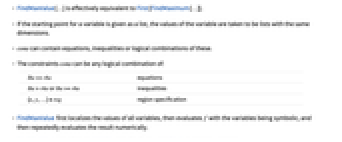FindMaxValue[f,x]
gives the value at a local maximum of f.
FindMaxValue[f,{x,x0}]
gives the value at a local maximum of f, found by a search starting from the point x=x0.
FindMaxValue[f,{{x,x0},{y,y0},…}]
gives the value at a local maximum of a function of several variables.
FindMaxValue[{f,cons},{{x,x0},{y,y0},…}]
gives the value at a local maximum subject to the constraints cons.
FindMaxValue[{f,cons},{x,y,…}]
starts from a point within the region defined by the constraints.


FindMaxValue
FindMaxValue[f,x]
gives the value at a local maximum of f.
FindMaxValue[f,{x,x0}]
gives the value at a local maximum of f, found by a search starting from the point x=x0.
FindMaxValue[f,{{x,x0},{y,y0},…}]
gives the value at a local maximum of a function of several variables.
FindMaxValue[{f,cons},{{x,x0},{y,y0},…}]
gives the value at a local maximum subject to the constraints cons.
FindMaxValue[{f,cons},{x,y,…}]
starts from a point within the region defined by the constraints.
Details and Options


- FindMaxValue[…] is effectively equivalent to First[FindMaximum[…]].
- If the starting point for a variable is given as a list, the values of the variable are taken to be lists with the same dimensions.
- cons can contain equations, inequalities or logical combinations of these.
- The constraints cons can be any logical combination of:
-
lhs==rhs equations lhs>rhs or lhs>=rhs inequalities {x,y,…}∈reg region specification - FindMaxValue first localizes the values of all variables, then evaluates f with the variables being symbolic, and then repeatedly evaluates the result numerically.
- FindMaxValue has attribute HoldAll, and effectively uses Block to localize variables.
- FindMaxValue[f,{x,x0,x1}] searches for a local maximum in f using x0 and x1 as the first two values of x, avoiding the use of derivatives.
- FindMaxValue[f,{x,x0,xmin,xmax}] searches for a local maximum, stopping the search if x ever gets outside the range xmin to xmax.
- Except when f and cons are both linear, the results found by FindMaxValue may correspond only to local, but not global, maxima.
- By default, all variables are assumed to be real.
- For linear f and cons, x∈Integers can be used to specify that a variable can take on only integer values.
- FindMaxValue takes the same options as FindMaximum.
List of all options

Examples
open all close allBasic Examples (4)
Scope (12)
With different starting points, get the values of different local maxima:
Value at a local maximum of a two-variable function starting from x=2, y=2:
Value at a local maximum constrained within a disk:
Starting point does not have to be provided:
For linear objective and constraints, integer constraints can be imposed:
Or constraints can be specified:
Find a maximum value of a function in a geometric region:
Find the maximum distance between points in two regions:
Find the maximum ![]() such that the rectangle and ellipse still intersect:
such that the rectangle and ellipse still intersect:
Find the maximum ![]() for which
for which ![]() contains the given three points:
contains the given three points:
Options (7)
AccuracyGoal & PrecisionGoal (2)
This enforces convergence criteria ![]() and
and ![]() :
:
This enforces convergence criteria ![]() and
and ![]() :
:
Setting a high WorkingPrecision makes the process convergent:
Gradient (1)
Method (1)
In this case the default derivative-based methods have difficulties:
Direct search methods that do not require derivatives can be helpful in these cases:
NMaximize also uses a range of direct search methods:
StepMonitor (1)
Steps taken by FindMaxValue in finding the minimum of a function:
WorkingPrecision (1)
Set the working precision to ![]() ; by default AccuracyGoal and PrecisionGoal are set to
; by default AccuracyGoal and PrecisionGoal are set to ![]() :
:
Properties & Relations (1)
FindMaximum gives both the value of the maximum and the minimizing argument:
FindArgMax gives the location of the maximum as a list:
FindMaxValue gives the value at the maximum:
Possible Issues (4)
If the constraint region is empty, the algorithm will not converge:
If the maximum value is not finite, the algorithm will not converge:
Integer linear programming algorithm is only available for machine-number problems:
Sometimes providing a suitable starting point can help the algorithm to converge:
Related Guides
Text
Wolfram Research (2008), FindMaxValue, Wolfram Language function, https://reference.wolfram.com/language/ref/FindMaxValue.html (updated 2014).
CMS
Wolfram Language. 2008. "FindMaxValue." Wolfram Language & System Documentation Center. Wolfram Research. Last Modified 2014. https://reference.wolfram.com/language/ref/FindMaxValue.html.
APA
Wolfram Language. (2008). FindMaxValue. Wolfram Language & System Documentation Center. Retrieved from https://reference.wolfram.com/language/ref/FindMaxValue.html
BibTeX
@misc{reference.wolfram_2025_findmaxvalue, author="Wolfram Research", title="{FindMaxValue}", year="2014", howpublished="\url{https://reference.wolfram.com/language/ref/FindMaxValue.html}", note=[Accessed: 10-December-2025]}
BibLaTeX
@online{reference.wolfram_2025_findmaxvalue, organization={Wolfram Research}, title={FindMaxValue}, year={2014}, url={https://reference.wolfram.com/language/ref/FindMaxValue.html}, note=[Accessed: 10-December-2025]}